Main lesson blocks are a central feature of Waldorf education. Are you wondering, “what is a main lesson block?” Let me show you what Waldorf homeschooling has looked like over the years in our house with three children.
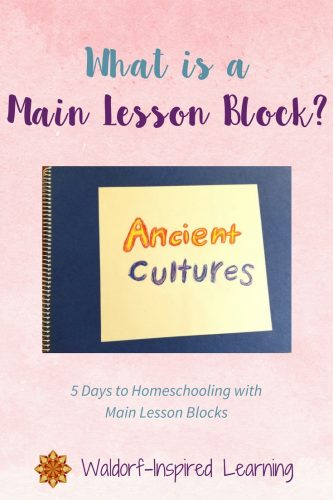
The Morning Main Lesson
The main lesson generally takes place each morning for about two hours. One topic is the focus during main lesson time, something like animal fables, farming and gardening, or ancient civilizations.
The topics for main lessons are chosen to suit a child’s developmental stage. Rudolf Steiner, the founder of the first Waldorf school, created the first list of main lesson block topics by grade. These topics have evolved over the years. And as homeschoolers, we have flexibility in choosing block topics to suit our particular children.
Want to see the traditional list of main lesson blocks? Check out the Waldorf Block Rotation, Grades 1-8.
A main lesson block lasts anywhere from three to six weeks during which one subject is the focus. These main lesson blocks are holistic and often interdisciplinary, with the arts, sciences, history, and literature interwoven into the topic of the block.
So what exactly does a main lesson look like in a homeschool setting?
I offer you this visual description of the set up for main lesson time at our house.
The Set Up for Main Lesson Block Learning
- a chalkboard for drawing and writing a story summary
- index cards with poems and verses and songs on them for warm-up time
- a basket of bean bags
- the story material for the day
- an idea of the drawing(s) we will do to highlight the story
- some modeling beeswax to keep little hands busy during the storytelling
- recorders for music
- a candle to create a mood of reverence
The Sequence of the Main Lesson
At our house, I signal that it’s time to begin lessons by playing a tune on the recorder. (It’s better than hollering up the stairs, believe me!) I pick a song to stick with for the season or even whole year. This beginning ritual can be adjusted based on the ages of your children and what works in your house.
Next comes Warm-Up Time. Commonly called Circle Time, I changed the name because older children do not appreciate having Circle Time as part of their schooling!
At our house, we warm up with a variety of activities in the middle of our living room – with songs, clapping games, stepping out rhymes, counting or multiplication recitation, bean bag passing or tossing.
Again, this will vary greatly depending on the ages of your children. It’s best to keep a few verses and songs that are familiar each time. and add a few new ones. We all benefit from some time to warm up our bodies and our minds, and come together as a group.
Warm-Up Time or Circle Time holds a surprising amount of skills-development. Children are learning foundational skills in literacy, math, and spacial awareness during these activities.
After warming up, we gather to light a candle and say an opening verse to help us focus and be present. Our candle sits on our Nature Table so we stand in front of that to recite our verse. Find a verse that suits your family and keep this the same all year.
After we’ve recited the opening verse, we blow out the candle and gather on the couch. With more than one child, I found it best to begin with the younger one’s story while the older children either listen in or do some work independently.
One important distinction of the Waldorf approach is that all new material is brought through story. In the early years, those are fairy tales, fables, and myths. As children grow, these stories become biographies and autobiographies of men and women in history, and stories of significant events.
So, we start with a story.
Next, it’s time to come to the table to work in the main lesson books. The educational journey of each block is recorded in a main lesson book which becomes a wonderful way to record and observe your child’s development over the years.
These main lesson books replace textbooks and worksheets in the Waldorf approach. Rudolf Steiner was committed to creating an approach that was lively, artistic, and engaging rather than abstract and dull like he witnessed in the schools of his era.
After the story and new material, we draw a picture into the main lesson book from the narrative that we just shared. The goal is to really take time with the drawing, filling the whole page with color.
After that, we might look back through the main lesson book at previous stories and talk about how the stories weave together (in the younger years) or how the story continues on (in the later years when each day brings a new installment).
Some days we’re finished at this point. Others, we might choose to extend the lesson with reading aloud from a related book, do a project or some other activity related to the lesson content. Then comes some math practice, work on a handwork project such as knitting or cross stitch, or perhaps some nature study outdoors.
The next day, we recall the story from the day before by retelling it together. This is a group effort, so be sure to be involved and tell some parts yourself, and then prompt your child to fill in some parts.
After recalling, children write a summary of yesterday’s story next to the picture they drew in their main lesson book yesterday.
For most of my children’s elementary years, I would draw on the chalkboard while they drew in their main lesson books. But you could alternatively draw on paper beside them, or tape the paper up on the wall.
When the lesson is over for the day, it’s nice to stand, hold hands if your child is willing, and say a closing verse to signify that main lesson time is over for the day!
The Importance of Rhythm
Want to read more about rhythm?
Go to this post: Rhythm Is (Always) the Answer.
Now you know the answer to “what is a main lesson block?” The main lesson block encompasses all three of these key elements: teaching through story, artistic hands-on activity, and rhythm.
What I’ve loved most about Waldorf homeschooling with main lesson blocks is how much my children stay engaged. If there happens to be a block that is less interesting to them, I can add in some artistic activities that I know they love. And, we get to start over every month or so. That way their interest stays fresh (and so does mine!)
5 Days to Homeschooling with Main Lesson Blocks
Hop around to all the posts in this series to find all you need to homeschool with main lesson blocks!
Day 1: What is a Main Lesson Block? (That’s this post!)
Day 2: Why Does Main Lesson Block Learning Work?
Day 3: The Essential Elements of a Main Lesson Block
Day 4: How to Plan a Main Lesson Block
Day 5: Recording the Learning in a Main Lesson Book

This series is part of the iHomeschool Network’s 5 Day Hopscotch. See what the other bloggers have shared and find tips, encouragement, and resources for your homeschool.


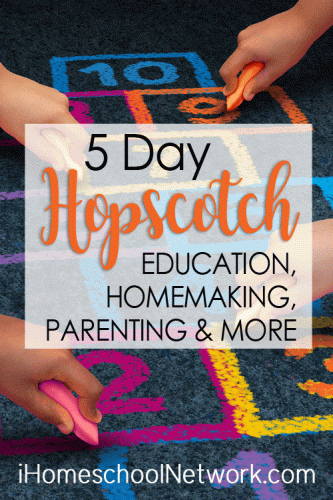
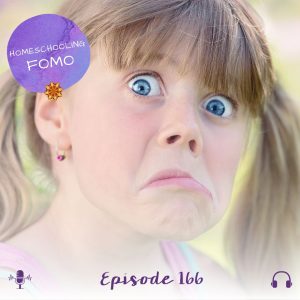

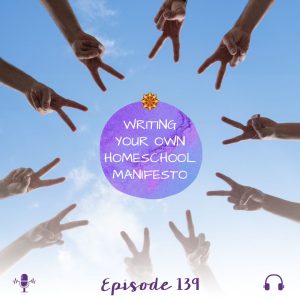

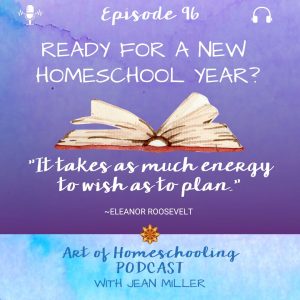
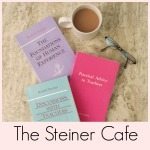

I have not done any main lesson blocks yet and would like to do a Saints block with my daughter but am not quite sure yet if I understand the way it works. If following the rhythm of introducing a new Saint story (or other story) on one day with some art, then retelling it the next day and writing a summary and maybe more art, what will happen on the third day? Do I tell another/ different Saint story? Do I keep up with this for 3-6 weeks? In this case then, the main lesson book would consist each of a drawing and summary of different Saints, right? I feel like it would be quite overwehleming to do it this way but am not sure, what to do instead. For other topics, such as ancient Rome or Celtic stories, how would it work there? I am really not sure how to weave it together and not have it be seperate entities that just so happen to stand next to each other, if that makes sense. Thank you so much
Good question, Nadine! Yes, on the third and fourth days, you repeat the rhythm that you did on day one and day two with a new story. And yes, you do this for 3-6 weeks. The main lesson book then has a drawing and a summary for each story. This works the same for all subjects. But as children get older, one story might take up multiple pages/drawings as the stories get longer and the summaries get longer. Hope that helps to clarify. You are on the right track! If you want more details on how this plays out through the grades, have a look at my Waldorf Homeschooling Simplified toolkit.